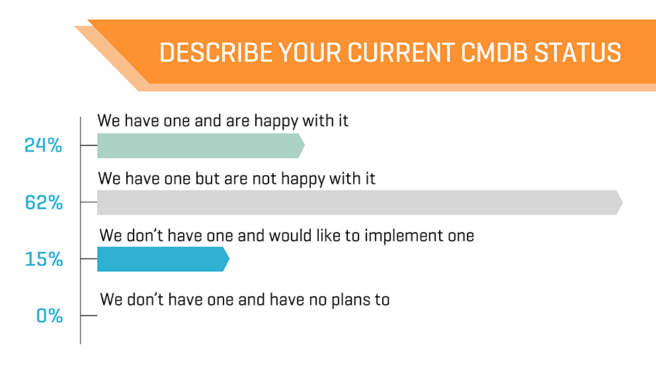77% of Enterprises Have a Missing or Deficient CMDB

Recently, Snow Software polled ITSM platform users on how they would describe their current CMDB status. The results are a stark indication of challenges organizations have with CMDBs.
We know how reliant business processes and IT operations are on the CMDB . It sits at the heart of provisioning and deployment processes. It supports the monitoring of infrastructure and business services. It supports governance, cost and resource management, and financial operations. With an effective CMDB, incident resolution is more efficient, change management processes actually work, and problem resolution processes have the needed foundation.
In addition, better asset management, identify software that is no longer needed, improve consolidation planning, and better address compliance issues. So, if the CMDB is that important, what is going on here? What makes it so difficult to build and maintain an accurate view of all relevant assets in the enterprise? In conversations with customers, a consistent set of reasons for CMDB failure emerge.
Inconsistent data. As the CMDB pulls data from numerous systems throughout the enterprise, different naming conventions across those systems create “dirty data” that make it difficult or impossible to perform key processes such as populating the Product and Service Catalogs.
Duplicate data. Lack of standardization and normalization leads to duplication of both attributes and Configuration Items. A common example is group license and multiple CI deployments.
Irrelevant data. Many organizations confuse the CMDB with an asset library, discovering and populating it with components not relevant to business services. An effective and efficient CMDB is used an operational tool, containing only the data it needs to support business and IT services.
Incomplete data. Organizations struggle with incomplete data sets, with attributes of services frequently not populated.
Manual update process. It is not uncommon for IT departments to spend years creating a CMDB only to find themselves forced to dedicate significant resources to maintain CMDB accuracy using time consuming expensive manual update processes. Fortunately, there is a better way to build and maintain a complete, accurate CMDB. In a recent webinar, ServiceNow consultant, Paul ‘Doc’ Burnham and Forrester Principal Analyst, Robert Stroud, provided insight into how to avoid common pitfalls and best practice approach to key topics including:
-
The importance creating a single source of truth for use by critical business and IT processes
-
Changes in the delivery of modern services including increasing user empowerment and demand for speed. These changes depend on a complete and accurate CMDB which, in turn, depends on automated data population and maintenance
-
How to replace manual data updates with automated processes
-
The role Snow for ServiceNow can play in creating standardized, normalized, clean data
The 45-minute webinar covered answers to viewer submitted questions, including those many CMDB owners face:
-
How can a complete and accurate CMDB help drive cost optimization?
-
What are the capabilities of ServiceNow with regards to discovery of configuration items and automating data record creation?
-
What key performance indicators can be used to measure the maturity of CMDB?
If you are struggling to get your CMDB working, even after investing years of effort, check out this on-demand webinar: Building a superior CMDB.